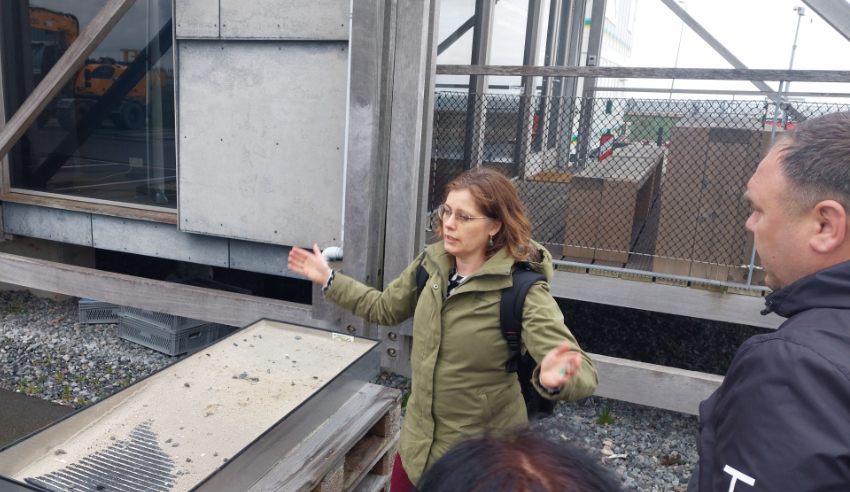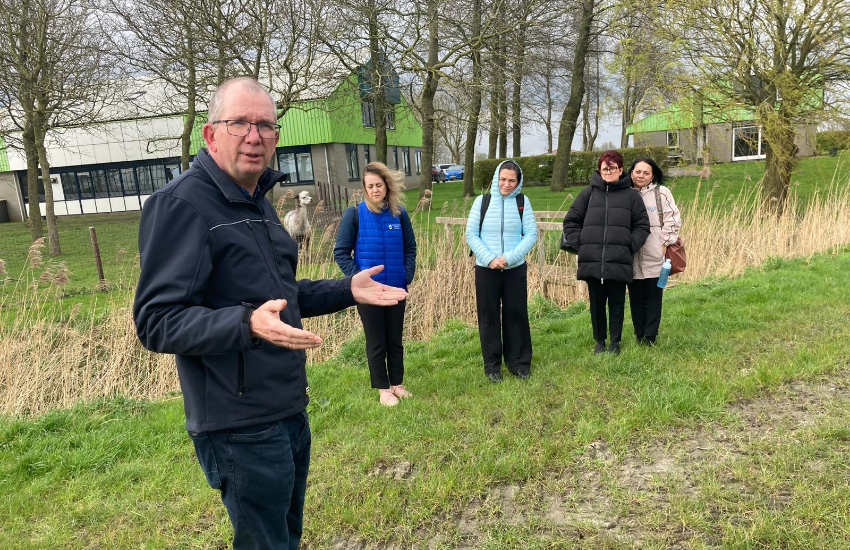In the first week of April, the Blue Deal Project team Tackling Drought Romania was welcomed at the Dutch water authority Noorderzijlvest by Roeland van der Schaaf, Chairman of the Board. They toured the North of the Netherlands to visit several projects with different tactics for tackling drought.

On the first day, the activities of Noorderzijlvest were presented in a short movie. After that, presentations followed about the Blue Deal project in Peru, the meeting in Bucharest of the bilateral panel, the activities of the Romanian partner Jiu Water Basin Administration, and the monitoring system used by Noorderzijlvest.
Michelle Talsma presented the STOWA project about combating drought in the Netherlands. She explained about the use of ESA satellite information about soil moisture, the Dutch Hydrological Instrument (NHI), measures such as Improvement of soil structure, Flexible water level management, Reduction of drainage, Fill in ditches, and the Use of climate resilient crops.
Agricultural Research Centre
In the afternoon, we visited the Agricultural Research Centre SPNA in Munnikezijl. SPNA is an independent research institute driven by farmers. Director Henk Westerhof explained that experiments related to organic agriculture (approximately 49 ha) and conventional agriculture (80 ha) are carried out here.
Organic farming uses crop rotation, cover crops, no-till farming (not disturbing the soil), no chemical fertilisers or other chemicals. The idea is not to feed the crop but to feed the soil. The amount of organic material in the soil will grow, which causes less pollution, a more hydrated soil, and less problems with dehydration of the soil. This can create a situation with 200% more biodiversity and a 90% reduction of the input in the agricultural system. On the question what is needed to introduce innovative crops, Henk’s answer was that it is all about marketing.

Lauwersmeer dike enforcement project
The day ended with a field trip and a presentation about stakeholders management during the implementation of the project to strengthen the Lauwersmeer dam. The project consists of the strengthening and raising of the dike for the defence of local communities with a length of 9.2 km. In the future, seawater will be let into the lake to restore the natural habitat. Therefore, it is an integrated approach for water safety and biodiversity. The project centre was visited, a centre where all types of meetings related to this work are organised.
Silvia Mosterd (from Noorderzijlvest) stressed that the Lauwersmeer project started with spending time for getting to know all the stakeholders, including the farmers who depend on fresh water. The salinity of the water will be measured in the future to determine the saline zone and the fresh water zone in the lake.
Wadden Centre
The following morning, we toured the Wadden Centre, a facility dedicated to the restoration of the Afsluitdijk. This dike serves as a barrier separating a lake for the accumulation of fresh water, which supplies the drinking water system to, for example, the capital city of Amsterdam, from the North Sea. In the future, fish will be able to migrate from the sea to the freshwater reservoir.
Fresh Future Texel
On the island of Texel, ACACIA Water (Tine te Winkel) and representatives of the Dutch water authority Hollands Noorderkwartier (Klaas Sjouke de Boer and Arnold Longeveld) explained about the project Fresh Future. This project aims to treat fresh water and store water in 2 underground layers. It was mentioned that during the rainy season normally the surface water is pumped into the North Sea. Now this water is partly stored in the soil and can be used in the dry season for agriculture.
The monitoring plan for this project and the operating principle of the water treatment facility for agricultural irrigation were presented. The presented project was promoted by the farmers of Texel. In the rainy season approximately 44 million cubic meters of fresh water are pumped into the North Sea. In the dry season there are no fresh water resources on the island of Texel. This is why several options/solutions for water supply for agriculture have been analysed for farmers, such as building a polder, building a pipeline to connect the island to the mainland, or naval transport.
Farmers on the island of Texel have crops of seed potatoes, sweet potatoes, onions, flower bulbs, wheat, and more. The soil has a good quality for all types of plants, but the water is not enough during the growing season for all species. The seed potato production is generally intended for export (Israel, Africa, Eastern Europe, Mediterranean countries, etc.).
The Dutch colleagues described the way the farmers are organised on Texel, the pilot projects implemented by them, the way of co-financing the projects, the cooperation of the factories interested in the problem of water management in areas affected by drought, the collaboration of farmers from the continental area with those from the island areas. It has been mentioned that without water no organism can develop in an ecosystem and without water, life will disappear.
Several workshop activities
On Thursday, workshop activities took place in the Ecomare complex on Texel. Discussions were opened related to the groundwater monitoring plan in the pilot area, the water balance and the Stakeholder CANVAS strategy. Action points were formulated to keep the project on track. On Friday, the Romanian delegation went home again.
